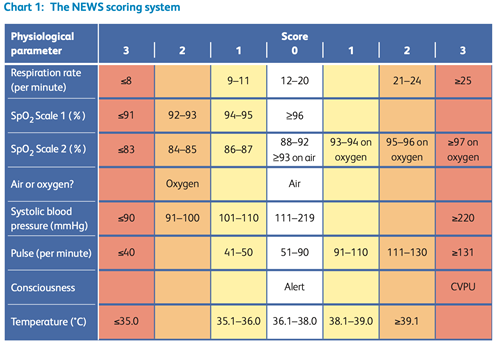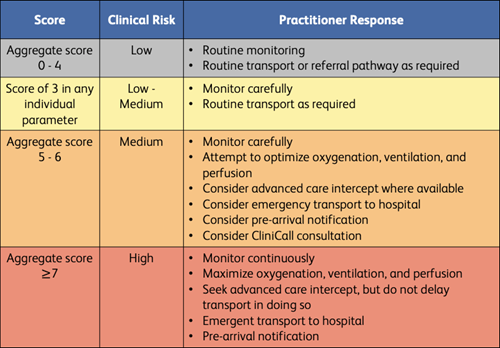Confirmation
K02: Sepsis
Updated:
Reviewed:
Introduction
Sepsis is a syndrome of life-threatening organ dysfunction resulting from a dysregulated host response to an infection. In Canada, 1 in 18 deaths are directly related to or complicated by sepsis, with the condition having prolonged psychosocial effects on survivors. Sepsis disproportionately affects the very young (below 1 year of age) and older adults (above 50). Paramedics and EMRs/FRs must recognize the potential for sepsis and be prepared to provide care to protect a patient’s airway, ensure adequate oxygenation and ventilation, and maintain end-organ perfusion.
Essentials
- The National Early Warning Score-2 (NEWS2) is a screening tool designed to identify patients at high risk for deterioration from all causes, including sepsis. Paramedics and EMRs should routinely obtain a NEWS2 score on all patients and use these findings to help guide management, including conveyance methods, pre-arrival notification, and in-hospital advocacy.
- Use appropriate personal protective equipment. For patients with suspected respiratory infections, paramedics and EMRs/FRs should use airborne droplet precautions.
- Patients with chronic fluid-retention (e.g., congestive heart failure or chronic renal failure) may also be fluid depleted and require fluid resuscitation. Assess for signs of volume overload continually throughout patient contact and stop infusion if edema becomes apparent.
Additional Treatment Information
- Sepsis can cause increased capillary permeability. All patients receiving fluid must be continually monitored for signs of volume overload, such as the development of pulmonary edema.
- Administration of vasopressors through peripheral IV lines carries a risk of significant extravasation injury. If vasopressors are used, they must be given through a 20G or larger IV catheter placed above the wrist. Paramedics must continually monitor for signs of extravasation; if swelling or pain around the IV site are present, the receiving facility must be notified immediately.
- Capillary blood glucose levels should be assessed in all patients with suspected sepsis. A measurement > 7.7 mmol/L, in the absence of diabetes, is suggestive of an underlying hypermetabolic state, which may be a sign of sepsis.
- Notify receiving facilities early for immunocompromised patients who are suspected of having sepsis. These patients often require isolation on arrival.
General Information
- NEWS2 relies on several physiological parameters already measured by paramedics and EMRs in their practice:
- Respiratory rate
- Oxygen saturation scale 1 (for patients without COPD)
- Oxygen saturation scale 2 (for patients with COPD)
- Systolic blood pressure
- Pulse rate
- Level of consciousness or new-onset confusion
- Temperature
- Primary risk factors for sepsis include:
- Age > 65
- Immunosuppression
- Diabetes
- Obesity
- Current diagnosis of cancer
- Hospitalization within the preceding 90 days
- In isolation, malodorous urine is not associated with a urinary tract infection.
- Elderly individuals with sepsis frequently do not present with a fever. Patients should be asked about antipyretic medications as these may mask a fever. In all patients, the absence of fever does not exclude sepsis. Hypothermia, where it is present, is an ominous sign in sepsis.
- Paramedics and EMRs should consider the possibility of meningococcal septicemia and invasive group A streptococcus (necrotizing fasciitis).
National Early Warning Score-2
BC Emergency Health Services advocates the use of the National Early Warning Score (NEWS2) to identify patients at risk of sudden deterioration. NEWS2 scores should be obtained on all patients, and used to guide clinical decision-making, particularly in the areas of conveyance, clinical pathway selection, pre-arrival notification, ongoing monitoring, and emergency department advocacy. Note: SpO2 Scale 1 is for patients not diagnosed with COPD; SpO2 Scale 2 is for patients diagnosed with COPD.


NEWS2 is not intended to replace sound clinical judgment. Its purpose is to alert practitioners to the risk of sudden deterioration and to help identify those patients who require more aggressive monitoring, treatment, and advocacy. NEWS2 is particularly valuable in the context of infectious diseases and suspected sepsis.
Interventions
First Responder (FR) Interventions
- Position supine to improve blood pressure if not in respiratory distress
- Do not walk the patient
- Supplemental oxygen as required
Emergency Medical Responder (EMR) & All License Levels Interventions
- Obtain and document NEWS2 score
- Provide supplemental oxygen to maintain SpO2 ≥ 94%
- Perform full-body assessment to examine for presence of mottling or non-blanching rash; consider meningococcal septicemia
Primary Care Paramedic (PCP) Interventions
- Obtain vascular access and correct hypotension or hypoperfusion
- Consider CPAP if necessary to support oxygenation in cases of respiratory infection
Advanced Care Paramedic (ACP) Interventions
- Concurrent use of vasopressors and fluid resuscitation is patient specific
- CliniCall consultation recommended to discuss care planning options.
- KetAMINE is the preferred induction agent if advanced airway management is required to maintain airway patency, oxygenation, or ventilation
Critical Care Paramedic (CCP) Interventions
- Hemodynamic support (maintain MAP > 65)
- Consider radial arterial line placement
- Consider femoral arterial line placement
- Consider norepinephrine
- Consider Vasopressin
- Consider Phenylephrine
- Consider Epinephrine
- Consider Dobutamine (ScVO2 ≥ 65)
- Ultrasound and IVCDI to determine fluid responsiveness
- Passive leg raise test
- Use a balanced crystalloid rather than saline
- goal of urine output of 50 ml/hr or 0.5ml/kg/hr
- Consider blood products (pRBC)
- Hgb > 70
- Consider adrenal insufficiency
- Respiratory support
- Consider NIPPV
- Consider IPPV
- Consider a recruitment maneuver
- Consider prone ventilation
- ARDSnet protocol
- Consider ABG/VBG analysis to guide therapy.
- Consider appropriate antimicrobial coverage
- Gram positive
- Gram negative
- Atypical coverage
- Antiviral
- Antifungal
Evidence Based Practice
Supportive
Neutral
Against
Supportive
Neutral
Against
References
- Alam N, et al. Prehospital antibiotics in the ambulance for sepsis: A multicentre, open label, randomised trial. 2018. [Link]
- Fernando SM, et al. Prognostic accuracy of the quick sequential organ failure assessment for mortality in patients with suspected infection: A systematic review and meta-analysis. 2018. [Link]
- Jiang J, et al. Head-to-head comparison of qSOFA and SIRS criteria in predicting the mortality of infected patients in the emergency department: a meta-analysis. 2018. [Link]
- Lane DJ, et al. Association between early intravenous fluids provided by paramedics and subsequent in-hospital mortality among patients with sepsis. 2018. [Link]
- Neviere R. Sepsis syndromes in adults: Epidemiology, definitions, clinical presentation, diagnosis, and prognosis. In UpToDate. 2019. [Link]
- Rhodes A, et al. Surviving sepsis campaign: International guidelines for management of sepsis and septic shock. 2017. [Link]
- Self WH, et al. Balanced crystalloids versus saline in noncritically ill adults. 2018. [Link]
- Semler MW, et al. Balanced crystalloids versus saline in critically ill adults. 2018. [Link]
- Schmidt G, et al. Evaluation and management of suspected sepsis and septic shock in adults. In UpToDate. 2019. [Link]
- Statistics Canada. Deaths involving sepsis in Canada. 2016. [Link]